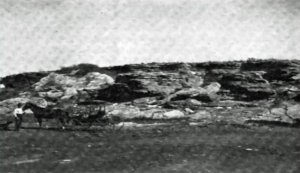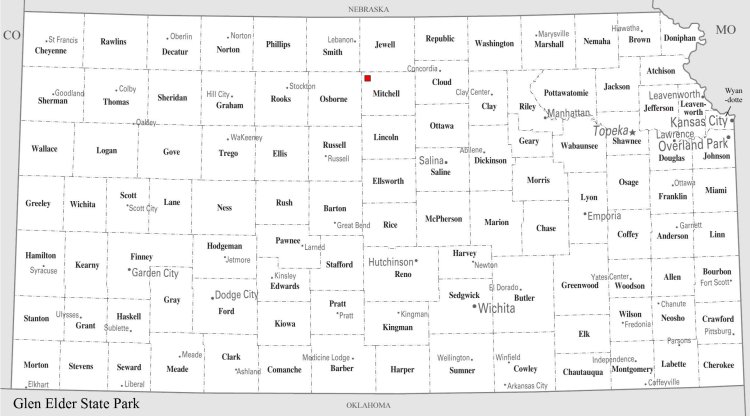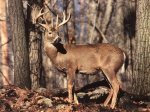
Long before Waconda Lake and Glen Elder State Park existed, the site was home to a famous landmark that drew visitors from miles around. This landmark was a spring, bubbling out from the top of a mound of its own sediments.
Waconda Spring took its name from the Kansa word Wakonda, or “Great Spirit.” The spirit of an Indian princess was believed to inhabit the spring and impart remarkable healing powers to the water (the spring was rich in minerals). Although located in Pawnee territory, the site was sacred to all. Any of the Plains tribes could visit it at will, always leaving offerings of beads, blankets, moccasins, and even weapons and other valued prizes.
There is some debate as to when white men first laid eyes on Waconda Spring. The first known visitor was Zebulon Pike, who passed by on his way to the Rockies in 1806. At first the white men stopped at the spring, recorded their observations, and moved on their way. Later, however, they began to stay. By the early 1870s, the Plains tribes were no longer able to make their ceremonial trips to the spring.
Although the white settlers did not believe in the various legends surrounding Waconda Spring, they soon concurred with the Indians in their opinion that its waters could heal. Mineral springs were rare in the area, so Waconda Springs quickly became an object of study. Some people were even of the opinion that the spring was bottomless, drawing its water directly from the ocean through an underground channel.
Bottled Waconda water became a nationally successful medicinal drink during the 1870s. Construction on a sanitarium began in 1884 and proceeded over the next 10 years. This development was expanded in 1906 to a full-fledged health spa.
The business around Waconda Springs prospered until about 1944, when the United States Bureau of Reclamation began eying the area as a potential site for a reservoir on the Solomon River for flood control and irrigation on the nearby farms. Both the owners of the health spa and the residents who had become attached to their historic spring objected. The proposed reservoir would flood Waconda Springs!
Samples of the water from Waconda Springs were analyzed by a hydrologist, proving them unique, but all in vain. The Great Flood of 1951 swept across the state, leaving destruction in its wake, particularly in Lawrence and Topeka. Flood control became a major concern in Kansas. Once again the subject of a reservoir at Waconda Springs came up.
This time, there was no stopping the wheels of progress. The spring site was sold in 1964 and construction began. Bulldozers shoved the health spa into the spring to fill it up. The dam was completed in 1969. The resulting Waconda Lake became the state’s third largest reservoir.
But Waconda Springs has not been forgotten. In the early 1990s, the Waconda Heritage Village Association was formed. Plans were made to commemorate the history of the spring, the Indians, and the pioneers through a living history museum. Work on this project has proceeded slowly but surely, contributing to Glen Elder State Park’s reputation as an excellent attraction.
Directions

- Follow Kansas Highway 9 west out of Concordia for about 39 miles.
- Watch for the state park entrance on the left past the town of Glen Elder.
Nature
Glen Elder State Park is a prime example of Smoky Hills scenery. Some oaks, elms, hickories, and cottonwoods grow along the streams, but the prairie scenery takes center stage. Be prepared for some breathtaking vistas!
This oasis on the plains attracts an impressive array of wildlife. During migration season, the lake and the woods along the river become a birdwatcher’s paradise. Beaver, raccoon, and white-tailed deer hide in the shelter of the trees. Out on the prairie, keep your eyes open for coyotes and the big mule deer.
Hunting
Diverse hunting opportunities are available at Glen Elder State Park. Quail, pheasant, ducks, geese, and both mule and white-tailed deer are present.
Special hunts are regularly organized and made available by drawing. Many of these events focus on children, but youngsters can enjoy hunting with a mentor all season long in a designated area on the north side of the lake. An area is also set aside for handicapped hunters on the southeast side of the wildlife area.
For extra practice, try the shooting range on the North Fork of the Solomon River, just south of the town of Downs.
Fishing

If fishing is your interest, try your luck at catching crappie, walleye, white bass, smallmouth bass, largemouth bass, channel catfish, and flathead catfish in Waconda Lake and the surrounding streams.
North of Kanza Campground is Chautauqua Fishing Pond, stocked specifically for children and handicapped anglers. In winter, however, it becomes an excellent place to go fly fishing for trout.
Trails
- Waconda Springs Replica Trail: This path is only a tenth of a mile long and was mainly made to showcase the Waconda Heritage Village. For more information, see “Other Opportunities” below.
- Native Trail: A quarter-mile loop between Sioux and Kanza campgrounds showcasing the native plants of the area. Be sure to come in late spring or early summer to enjoy the wildflowers. Hiking only.
- Sunflower Trail: This linear walking path is about a third of a mile long one way. Both trees and open views are presented for your enjoyment. The trailhead is across the road from the trailhead for the Native Trail.
- Woodlands Trail: Not really the most wooded path in the state park system, but still a great way to see native trees. While you’re at it, you’ll get a good look at Chautauqua Fishing Pond. This hiking trail is just short of half of a mile one way.
Other Opportunities
For a taste of history, take a walk down the Waconda Springs Replica Trail north of Kanza Campground. The first stop will be Hopewell Church, built in 1878 to serve the nearby town of Beloit and moved to its present location in 1994 as the first step in the creation of the Waconda Heritage Village. Murals illustrating the legends of the springs have been painted in the basement; ask for the key at the park office. The centerpiece of the village, however, is the replica of Waconda Springs. Interpretive signs explain the significance of the spring.
If the history of the Plains tribes interests you, you might also enjoy the annual Wakonda Indian Festival, featuring authentic Native American performances and craftsmanship.
Helpful Resources
Glen Elder State Park
Information to help you plan your trip. A brochure is also available.
Waconda Springs
More about the history of the springs.
Hopewell Church
More about the history of the church.



